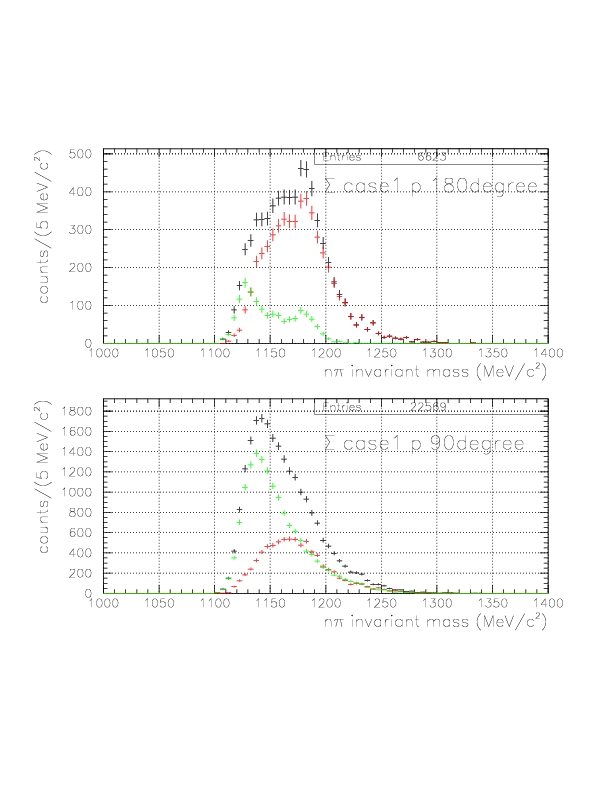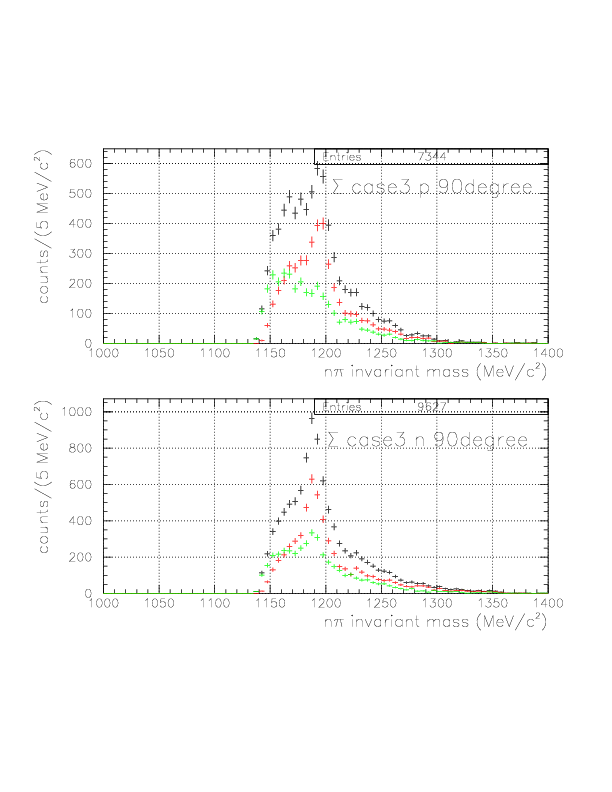




Here we perform p&Sigma-/n&Sigma correlation analysis with E549+E570 full statistics.
| YN pair(dibaryon/tribaryon channel) | case ID(Selection) | Angler acceptance | PA/PB/NT particle | TC particle | No. of reconstructed &Sigma | No. of event after A | No. of event after B (yield of &Sigma N pair with well-defined momenta) |
|---|---|---|---|---|---|---|---|
| &Sigma-p(X0/S0) | 1(C-b-1-x/A-b-3-x) | 180+-30 | n+p | &pi | 1617/1639/654 | 1569/1581/632 | 1487+1581+620=3688 |
| &Sigma-p(X0/S0) | 1(C-b-x-1') | 90+-45 | n | &pi+p | 2179/2208/1071 | 1544/1620/752 | 1544+1620+752=3916 |
| &Sigma+-n(X+/S+) | 1(C-b-3-x) | 180+-30 | n+n | &pi | 1562/1584/715 | 992/1017/457 | 992+1017+457=2466 |
| &Sigma+-n(X+/S+) | 1(C-b-x-3') | 90+-45 | n | &pi+n | 1189/1152/537 | 1189/1152/537 | 1189+1152+537=2878 |
| &Sigma-p(X0/S0) | 2(B-c-1-x) | 90+-45 | &pi+p | n | 272/296/127 | 258/280/119 | 232+280+110=622 |
| &Sigma-p(X0/S0) | 2(B-c-x-1'/B-a-x-3') | 180+-45 | &pi | n+p | 1676/1759/689 | 1467/1535/602 | 1387+1535+586=3508 |
| &Sigma+-n(X+/S+) | 2(B-c-3-x) | 90+-45 | &pi+n | n | 426/484/168 | 426/484/168 | 406+484+164=1054 |
| &Sigma+-n(X+/S+) | 2(B-c-x-3') | 180+-45 | &pi | n+n | 515/485/189 | 515/485/189 | 487+485+185=1157 |
| &Sigma-p(X0/S0) | 3(B-a-3-x) | 90+-45 | &pi+n | p | 991/1063/415 | 695/723/291 | 657+723+281=1661 |
| &Sigma+-n(X+/S+) | 3(B-c-3-x) | 90+-45 | &pi+n | n | 1379/1368/517 | 1379/1368/517 | 1305+1368+509=3182 |
The definition of variables are as follows:
&Sigma 4-momentum p&Sigma(0:3)/3-momentum p'&Sigma(3):p'&Sigma(i)=pp(i)+p&pi(i), p&Sigma(i)=p'&Sigma(i) (i=1,2,3), p&Sigma(0)=sqrt(M&Sigma2+|p'&Sigma|2),
Nucleon 4-momentum pN(0:3)/3-momentum p'N(3):pN(i)=p'N(i) (i=1,2,3), pN(0)=sqrt(MN2+|p'N2|)cos(N&Sigma):p'&Sigma*p'N/(|p'&Sigma|*|p'N|)
N&Sigma total 3-momentum Ptot:sqrt((p&Sigma(1)+pN(1))2+(p&Sigma(2)+pN(2))2+(p&Sigma(3)+pN(3))2)
N&Sigma total energy Etot:p&Sigma(0)+pN(0)
N&Sigma invariant mass Minv:sqrt(Etot2-Ptot2)
4He(stopped K-,N&Sigma)X missing mass Mmiss:sqrt((M4He+MK--Etot)2-Ptot2)
The results are exhibitted below for all event topologies: